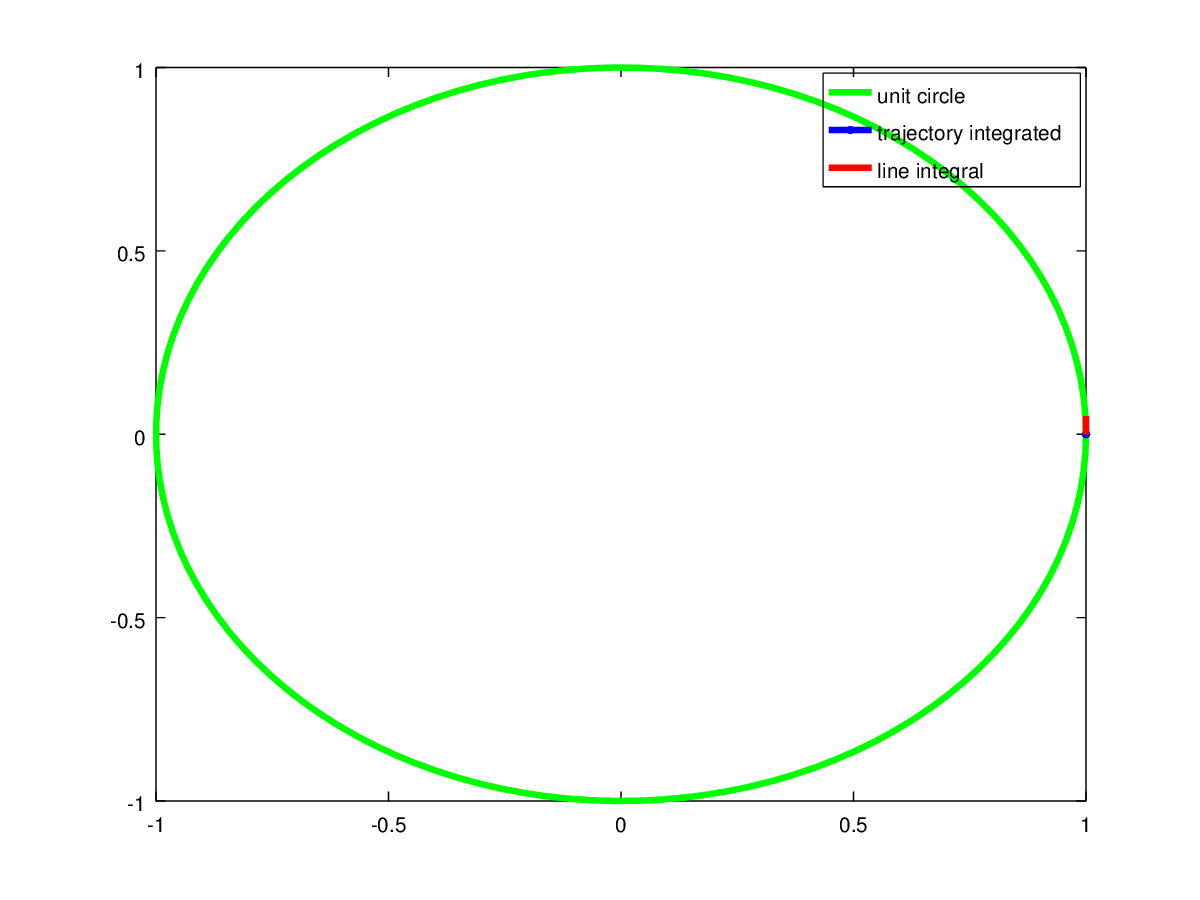Maybe one way that will help the understanding is to consider the integral
$$\int_0^{\theta_0} {\hat \theta} d{\theta}$$
I am assuming $\hat \theta$ defined in this way:
$${\hat \theta} = \begin{bmatrix}-\sin(\theta)\\\cos(\theta)\end{bmatrix}$$
It will be unit vector because of the trigonometric identity: $\sin(\theta)^2+\cos(\theta)^2 = 1$. We can also convince ourselves that it will be orthogonal to $\begin{bmatrix}r\cos(\theta)\\r\sin(\theta)\end{bmatrix}$ which is often defined to be the radial component.
If we approximate the integral using a computer, we see a relation between the angle integrated, the unit circle and the line integral result:
 The end points of the blue line are angles $0$ and $\theta_0$ on the unit circle. And the red vector is the vector from point $(1,0)$ pointing onto the unit circle at angle $\theta_0$. (I could not find any arrowhead to indicate the direction).
The end points of the blue line are angles $0$ and $\theta_0$ on the unit circle. And the red vector is the vector from point $(1,0)$ pointing onto the unit circle at angle $\theta_0$. (I could not find any arrowhead to indicate the direction).
Note that, in a sense, the constraint one-form $\omega$ is not itself "physically meaningful": What matters the distribution $\mathcal{D}$ of "allowed directions", and there are many possible choices of (local) generating one-forms, and any interpretation of $d\omega$ will have to take this redundancy into account. Still there is a useful interpretation of $(d\omega)|_\mathcal{D}\neq 0$ as saying that the constraint $\omega(\dot{q})=0$ can be effectively circumvented by local motion.
Throughout, let $\mathcal{D}$ be a smooth distribution of constant rank on a manifold $M$, and $\Omega^kM$ denote the set of differential $k$-forms on $M$.
1.An aside on the Frobenius theorem
Given a differential form $\omega$. we may restrict it to $\mathcal{D}$ to obtain a smoothly varying alternating multilinear form $\omega|_\mathcal{D}$ on $\mathcal{D}$. The key property of one-forms that define the constraint is that they vanish when restricted in this way. Instead, we can define the set of all differential forms (of any order) which vanish when restricted to $\mathcal{D}$, denoted by $I_\mathcal{D}=\{\omega\in\Omega^kM:\omega|_\mathcal{D}=0\}$, which has a few useful properties.
- $I_\mathcal{D}$ is uniquely determined by the distribution $\mathcal{D}$.
- $I_\mathcal{D}$ is an ideal of of the algebra of differential forms, in the sense that for any $\omega\in I_\mathcal{D}$ and $\mu\in\Omega^kM$, we have $\omega\wedge\mu\in I_\mathcal{D}$.
- If defining one-forms $\omega_1,\cdots,\omega_m$ generate $\mathcal{D}$, then they also generate the ideal $I_\mathcal{D}$, in the sense that
$$
I_\mathcal{D}=\left\{\sum_{i=1}^m\omega_i\wedge\mu_i:\mu_1,\cdots,\mu_m\in\Omega^k M\right\}\cup\{0\}
$$
A beautiful result known as the Frobenius theorem states that a distribution $\mathcal{D}$ is integrable (i.e. holonomic) if and only if the corresponding ideal is closed under exterior differentiation, i.e. $\omega|_\mathcal{D}=0\implies (d\omega)|_\mathcal{D}=0$. This implies we should look at the restriction $(d\omega)|_\mathcal{D}$ rather than $d\omega$ itself, and that this restriction should somehow indicate the extent to which the constraint imposed be $\omega$ fails to be integrable.
2. "Violating" constraints with local motion
Let $\omega\in I_\mathcal{D}$ be a constraint one form, and $X,Y\in\Gamma(D)$ be two vector fields compatible with the constraints. Starting at a point $p$ we can define a constraint-satisfying path with a time parameter $\tau$ and a speed parameter $v$:
- Flow along an integral curve of $vX$ for time $\tau$,
- flow along an integral curve of $vY$ for time $\tau$,
- flow along an integral curve of $-vX$ for time $\tau$,
- flow along an integral curve of $-vY$ for time $\tau$,
- repeat ad infinitum.
One can show that in the limit $\tau\to 0,v\to\infty$ with $v^2\tau=1$, this path approaches an integral curve of the Lie bracket vector field $[X,Y]$, so $[X,Y]$ is a kind of "average velocity" from alternately moving back and forth along $X$ and $Y$. We can then ask if this average velocity satisfies the constraint imposed by $\omega$:
$$\begin{align*}
\omega([X,Y])=&\omega([X,Y])+0-0 \\
=&\omega([X,Y])+X(\omega(Y))-Y(\omega(X)) \\
=&d\omega(X,Y)
\end{align*}$$
We see that it satisfies the constraint precisely when the vector fields satisfy $d\omega(X,Y)=0$. Conversely, if $(d\omega)|_\mathcal{D}\neq 0$ at $p$, we can find vector fields $X,Y$ which satisfy the constraints such that their alternating flow in the manner described above, starting at $p$, "violates" the constraint.
3.Your example, and parallel parking
If you're familiar with parallel parking, you have already seen this principle in action. Most automobiles are described more or less accurately by your model, in that they have a "heading" direction and can only move forward/backward along that direction or rotate their heading. However, by alternating small clockwise/counterclockwise rotations and forward/backward motion, they can effectively move perpendicular to their heading.
You can explicitly compute this: At the point $(x,y,\theta)=(0,0,0)$, the constraint $\omega_{(0,0,0)}=dy$ forbids motion in the $y$ direction. However, choosing vector fields $X(x,y,\theta)=\cos\theta\partial_x-\sin\theta\partial_y$ and $\Theta(x,y,\theta)=\partial_\theta$, we have $[X,\Theta]_{(0,0,0)}=\partial_y$ and $d\omega(X,\Theta)_{(0,0,0)}=1$, so alternately moving along these vector fields will result in effective motion in the $y$ direction.

Best Answer
Here, the derivative represents the velocity of a body undergoing circular motion. Since this velocity is always a tangent to the location of the body, it indicates that the velocity is always tangential to the circle on which the body moves.
The length of this vector gives you the magnitude of the velocity. In this case, the length is 1, but if you are moving on an ellipse, or a larger circle, the equation becomes $$e_r = a\cos \theta i + b\sin \theta j$$ $$\frac {de_r}{d\theta} = -a\sin\theta i + b\cos\theta j$$
here, the magnitude plays a more important role as you can see clearly that the velocity is not the same at different points of motion if $a \ne b$.